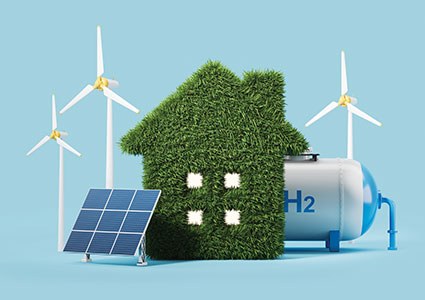
How could gas pave the way for a new generation of low-carbon energy? By Victoria Mustard
Green energy made huge strides last year. In November, more than 20GWh of electricity was produced by wind for the first time, representing over 70 percent of electricity generated that day. In the EU, wind turbines and solar panels delivered more power than natural gas for the first time. Yet, the UK remains heavily reliant on natural gas for electricity generation, heating and energy-intensive industries. In the past year alone, over 40 percent of electricity was generated by burning fossil fuels such as gas or coal.
The government’s Net Zero Strategy has a strong focus on electrification to decarbonize energy in its broadest sense. The strategy also predicts that the demand for power that electrification will bring will rise by up to 60 percent, as energy production moves away from fossil fuels and towards renewables. The challenges arising from this increase have to be considered, including how quickly capacity can be brought online to meet the new demands.
 Grid constraint is currently an issue, where too much energy is being produced for the electricity grid to manage, resulting in switching off wind to cease generating energy. In 2020, when consumer demand fell as a result of the coronavirus lockdown, National Grid spent an unprecedented £826 million balancing the grid, primarily in the form of payments to wind farm producers to cease generation.
Grid constraint is currently an issue, where too much energy is being produced for the electricity grid to manage, resulting in switching off wind to cease generating energy. In 2020, when consumer demand fell as a result of the coronavirus lockdown, National Grid spent an unprecedented £826 million balancing the grid, primarily in the form of payments to wind farm producers to cease generation.
Therefore, the energy industry and policymakers need to start asking questions about the practicalities of decommissioning gas networks or upgrading electricity infrastructure to support any proposed changes. Whichever route is taken to decarbonizing current gas demand, it will need to replace the 738TW of energy that natural gas produces on an annual basis and one thing is certain; there isn’t a one-stop fuel solution for reaching net zero.
So, what role does gas have to play in supporting emerging low-carbon energy?
Limitations of 100 percent renewable energy
Renewable energy from solar and wind is inescapably intermittent and would need tremendous battery storage to maintain demand on overcast and still days or weeks. With battery technology some distance from meeting the scale needed, for now, the UK can’t sustain itself on 100 percent renewable sources. However, a low-carbon gas network, for example, hydrogen or biogas, could provide supportive energy services, such as seasonal storage, domestic heating or high-temperature heat for industry.
Factoring in the current constraints of renewable energy, it’s unwise to say with certainty that a single fuel could provide a net zero system that ensures energy security, guarantees affordability and meets consumer demand by 2050. Instead, the UK’s energy transition will likely need to include a blend of technologies and fuel sources.
Hydrogen as a source of low-carbon, on-demand energy
Hydrogen represents a promising solution for decarbonizing gas. The existing gas network could be adapted to facilitate the production and transportation of cost-effective, on-demand hydrogen using existing infrastructure.
Hydrogen poses a potential solution to work alongside electrification to bridge the gap for hard-to-abate sectors such as glass, steel & ceramics manufacture, ensuring these sectors’ viability in the global market. The Climate Change Committee (CCC) predicts low-carbon blue hydrogen, produced from natural gas with carbon capture usage and storage (CCUS), will play a key role in meeting energy demands until infrastructure, supply chains and energy codes can fully support renewable sources to produce green hydrogen.
With the opportunity to invest and utilize CCUS, the gas industry could support the government’s targets to scale blue and green hydrogen production, as set out in the British Energy Security Strategy, published in April 2022.
Given the timescales to build renewable infrastructure and implement energy efficiency improvements, using an existing gas network in the short term could provide fast results for emissions reductions.
Gas networks are already exploring hydrogen as an alternative energy source. The Hydeploy trials have proved that hydrogen blends of up to 20 percent can be safely deployed into the existing gas network, without the need to replace pipes or appliances. Hydrogen for heat is a contentious issue with many arguments for and against.
Xoserve is proud to support the Hydrogen for Heating trials, with the first domestic heating trial at H100 Fife in 2024 and then the planned Hydrogen Village in 2025. The information gathered will provide essential data and evidence to support the Government’s decision on whether hydrogen could support domestic heating (expected to be made in 2026).
Backing up hydrogen sustainability claims
If decarbonization is the primary reason for developing hydrogen, it’s going to be vital that the gas market can disclose the emissions of each product, depending on how the hydrogen is produced.
One way to achieve this is through a Hydrogen Guarantees of Origin (GoO) scheme, similar to the renewable guarantees of origin schemes available in the electricity market. This could verify the emission in the production of hydrogen, enabling businesses to claim their low or zero carbon gas credentials.
The future of gas in a low-carbon energy market
Should hydrogen form part of the energy transition, then developing a new hydrogen market will be crucial to the energy transition – the question is, what would that model look like? Perhaps most importantly, how can the risk of volatility be reduced to minimize the threat of reliving another energy crisis?
 Urgent direction from the government is needed to secure the UK’s energy economy, as global competition for low-carbon energy is showing no signs of slowing down. If the UK were to develop hydrogen as an energy source, investors need to believe they won’t gain higher returns elsewhere.
Urgent direction from the government is needed to secure the UK’s energy economy, as global competition for low-carbon energy is showing no signs of slowing down. If the UK were to develop hydrogen as an energy source, investors need to believe they won’t gain higher returns elsewhere.
Although the end destination – a low-carbon energy system – is undoubted, the timeframe and route are still unknown. In the short term, it’s not about gas versus electrification, but a combined discussion on the best way to blend numerous technologies to suit all energy consumption.
Whatever that path might look like, it’s almost certain there won’t be an exclusive fuel source. Policymakers and the energy industry as a whole need to work together to develop a variety of solutions. For this to happen, natural gas, in some form, has to play a role in the energy transition.
For a list of the sources used in this article, please contact the editor.
Victoria Mustard is Decarbonisation Strategy Lead at Xoserve. Xoserve is the Central Data Services Provider (CDSP) for the gas industry, administering the UK Link system, which holds the details of over 24 million gas meter points in Britain. Xoserve is a non-profit organization funded, governed and owned by the gas industry to provide vital services for suppliers, shippers and transporters to ensure that Britain’s retail gas market runs efficiently and reliably.